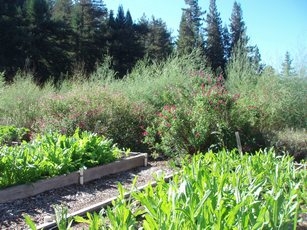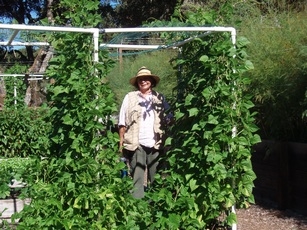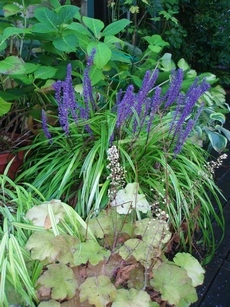Lindencroft Farm is a great example of a local family doing what they love and making a living, too. You can see it in the new crop of Necores carrots just sprouting and being watched over by the family farm cat that was sitting on the edge of the retaining wall. Linda explained this is one of her favorite carrots because she doesn’t have trouble with it forking and it isn’t bothered by summer heat. Every crop that is grown on the farm is researched for best flavor and vigor.

Walking around, I saw many Italian names as she specializes in Italian peppers. She gets seed from organic seed companies in this country, Italy and France. Some of her favorite vegetables are Rosa Bianca eggplant as it is almost never bitter. She also likes Red Russian and Lacinato or dinosaur kale.
Tat soy and bok choy are favorites in the CSA boxes. She grows beans of all types– french filet, romano, shelling. Golden beets ( my personal favorite ), all kinds of potatoes- fingerlings, Russian banana, red thumb, German butter, red lasoda and other heirlooms. The beds overflow with life.
I tasted the last of the cherry tomatoes. Rosalita, a red grape type, was good but the white cherry tomato was the best. Herbs grow in several boxes and the farm can’t seem to grow enough asparagus to satisfy the demand.
Insect control is easy, Linda said. If fungal diseases persist she plants a crop of beans and that seems to solve it. Occasionally aphids or spider mites get the upper had, but rather than spray even with organic soap she finds she has better results by monitoring the plants often and spraying with a hard blast of water or cutting or pulling out infested plants. For fava beans that seem to always attract big black aphids, she harvest the beans and flowers while very young before aphids get a hold.
The farm is entirely powered by 78 solar panels. Recaptured rainwater is stored in a rainwater basin that holds a half a million gallons and is filtered twice before using. They collect this from just 2-3 good winter storms. Water from their own deep well is used in the beginning of the year with the rainwater used in the hot summer months.
I asked Linda if the cool spring this year impacted her plants and she said yes, ‘"Everything is three weeks late." Our early October rains caused her tomatoes to get fungal diseased so they had to harvest them all, while some of the squash now has powdery mildew and has to be pulled up early. As we were talking she told some workers harvesting squash in another part of the farm to cut out the growing tips so the remaining squash would receive all the energy of the plant to ripen before the weather turns cold. The sunflowers being visited by a flock of chickadees was looking a bit bedraggled, too.
We watched some workers putting up frames for plastic hoop houses that will protect peppers crops from the rains and extend the harvest this year. Even potatoes benefit from this cover as overly wet soil contributes to fungal diseases. Lettuces, chard, kale and other leafy greens would get tattered by the rains if not covered.
Walking and talking, Linda would reach down and pick a sprig of bronze fennel or hyssop for me to enjoy. it’s clear that she is gentle on the earth and a good steward of the land. The entire farm is surrounded by redwood forest and oak meadowland, teaming with wildlife. Her philosophy of farming is to gently coax the best produce by creating as natural an environment as she can. Each year, the farm is healthier, most robust and more beautiful than the last.

 Steven, started the farm in 2007. Their 90 acres is zoned mixed agriculture but since some of it encompasses rare Ben Lomond sandhills habitat, they farm just a couple of acres. They have even installed a wide deer corridor separating the growing areas to allow the deer access to their feeding and watering places.Tall fences protect the beds from other critters but they encourage the birds and bees by planting flowers that seed, attract beneficial insects and produce pollen.
Steven, started the farm in 2007. Their 90 acres is zoned mixed agriculture but since some of it encompasses rare Ben Lomond sandhills habitat, they farm just a couple of acres. They have even installed a wide deer corridor separating the growing areas to allow the deer access to their feeding and watering places.Tall fences protect the beds from other critters but they encourage the birds and bees by planting flowers that seed, attract beneficial insects and produce pollen.  Don’t prune now, you’ll be happy to hear. Fall is not a good time to prune. Wounds heal slowly, leaving them more susceptible to disease. As a general rule, don’t prune when leaves are falling or forming. Wait to prune most trees until late in the dormant season or in late spring after leaves and needles form. To avoid sap flow on birches and maples, prune after leaves mature.
Don’t prune now, you’ll be happy to hear. Fall is not a good time to prune. Wounds heal slowly, leaving them more susceptible to disease. As a general rule, don’t prune when leaves are falling or forming. Wait to prune most trees until late in the dormant season or in late spring after leaves and needles form. To avoid sap flow on birches and maples, prune after leaves mature.  up when the first drops started to fall. Everything looks brighter and more vivid now. I can even get a shovel in the earth to turn over the soil in those dry spots where I’d love to plant a new tree or shrub. The soil is still warm and will nurture new root growth. It’s a good time to plant a new fruit tree, edible shrub like a blueberry or maybe even something with beautiful fall color.
up when the first drops started to fall. Everything looks brighter and more vivid now. I can even get a shovel in the earth to turn over the soil in those dry spots where I’d love to plant a new tree or shrub. The soil is still warm and will nurture new root growth. It’s a good time to plant a new fruit tree, edible shrub like a blueberry or maybe even something with beautiful fall color.
 wet winters. After Glow is frost tolerant and looks to be painted with florescent paint. There are spectacular hybrids being developed every year. These are not as hardy as the traditional hens and chicks but well worth the effort to find a place where they can survive a freeze. Frilly Mauna Loa sports turquoise and burgundy foliage while echeveria Blue Curls looks like an anemone in a tide pool.
wet winters. After Glow is frost tolerant and looks to be painted with florescent paint. There are spectacular hybrids being developed every year. These are not as hardy as the traditional hens and chicks but well worth the effort to find a place where they can survive a freeze. Frilly Mauna Loa sports turquoise and burgundy foliage while echeveria Blue Curls looks like an anemone in a tide pool.  I love those huge, showy tulips as well as the new colors of daffodil and narcissus coming out each year. Can’t live without them. But I want to add to the show next spring. Maybe I’ll plant Spring Starflower or Ipheion. Their starry white flowers bloom over a long period in spring and they naturalize easily. Spring Snowflake ( leucojum vernum ) will also naturalize in the garden. The flowers are small and bell shaped, white with a green or yellow spot and have a slight fragrance. And I want to include some species tulips. They will rebloom year after year just like they do in the wild in Europe, North Africa and Asia.
I love those huge, showy tulips as well as the new colors of daffodil and narcissus coming out each year. Can’t live without them. But I want to add to the show next spring. Maybe I’ll plant Spring Starflower or Ipheion. Their starry white flowers bloom over a long period in spring and they naturalize easily. Spring Snowflake ( leucojum vernum ) will also naturalize in the garden. The flowers are small and bell shaped, white with a green or yellow spot and have a slight fragrance. And I want to include some species tulips. They will rebloom year after year just like they do in the wild in Europe, North Africa and Asia.